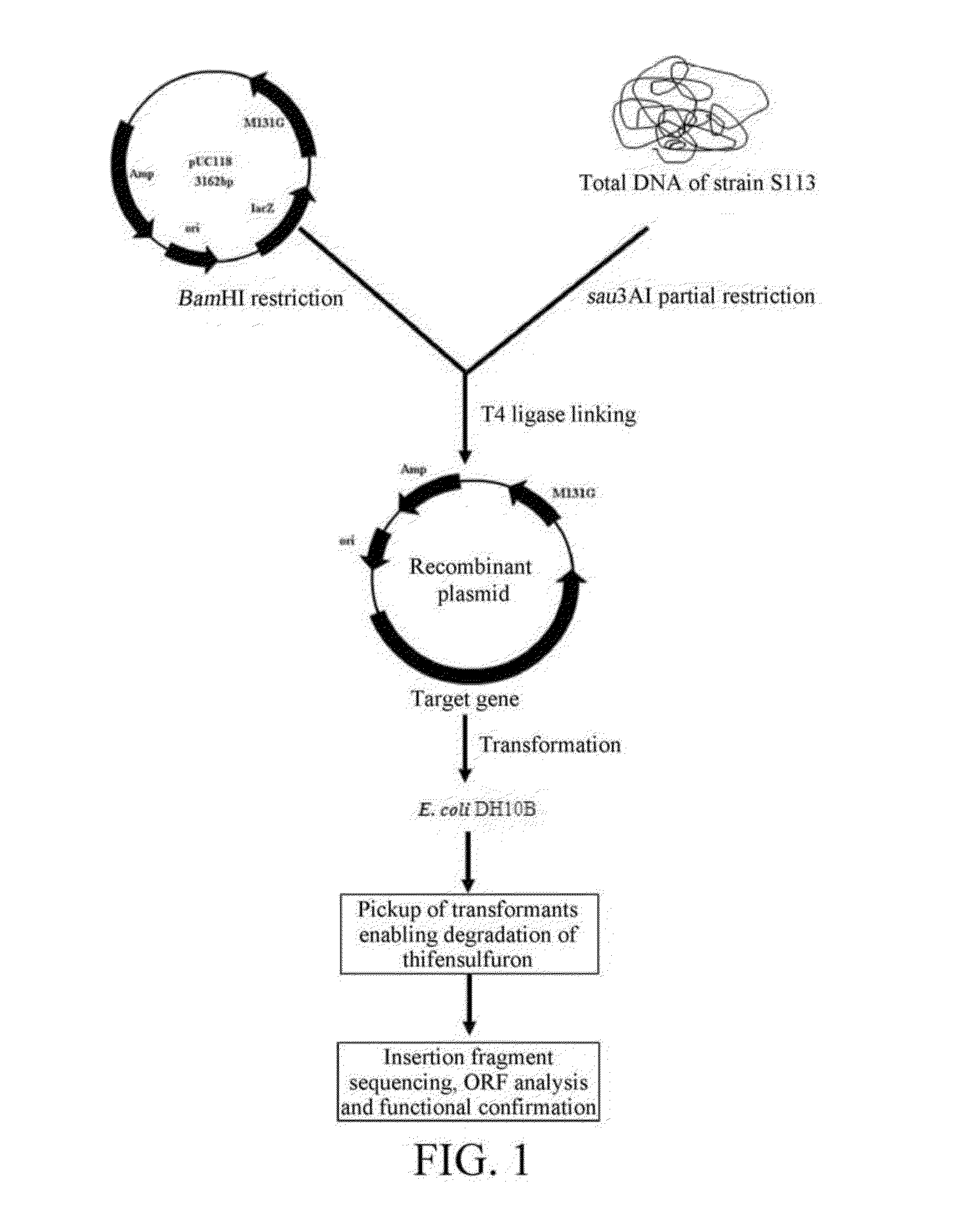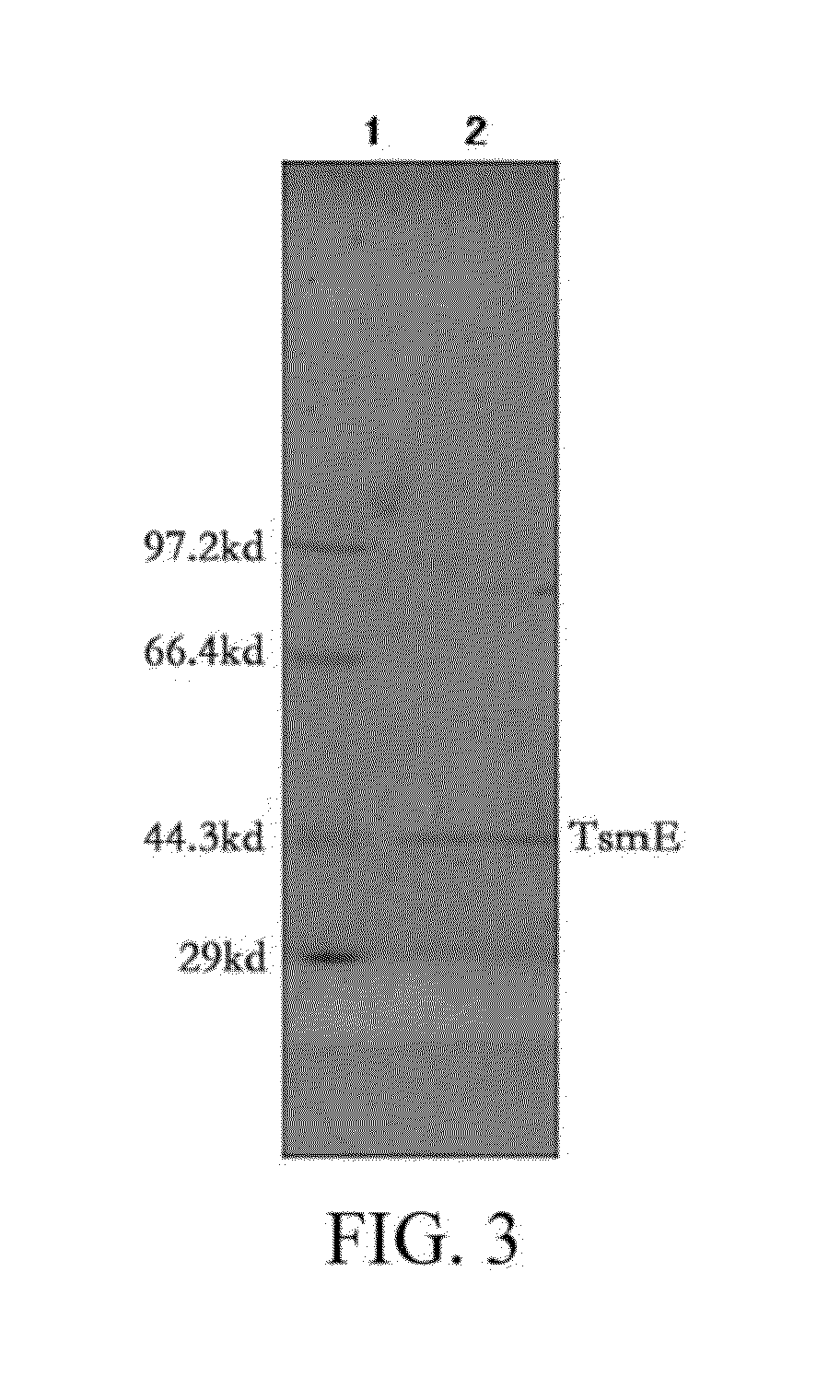Thifensulfuron hydrolase gene TSME and uses thereof
- Summary
- Abstract
- Description
- Claims
- Application Information
AI Technical Summary
Benefits of technology
Problems solved by technology
Method used
Image
Examples
embodiment 1
Cloning of the Thifensulfuron Hydrolase Gene
[0036]1.1 Extraction of Total DNA from Bacterial Genome
[0037]Cells of strain S113, cultured in R2A medium for 48 h, were harvested by centrifugation and then the total DNA was extracted by the CTAB method as described by F. Osbourne et al, ed. Concise Guide to molecular biology experiments. The total DNA was dissolved in TE buffer (pH8.0), and stocked at −20° C.
[0038]1.2 Digestion of the Total DNA of Strain S113
[0039]The total DNA of strain S113 was partial digested by Sau3AI
[0040]1.3 DNA Recovery
[0041]The restricted total DNA was purified by electrophoresis (TAE buffer), and recovered by a recovering kit (Axygen Biosciences, china). The recovered DNA was dissolved in 10 mmol / L Tris-HCl (pH8.0) and stocked at −20° C.
[0042]1.4 Enzymatic Ligation
[0043]The reaction system was as follows:
pUC118 (BamHI)0.1μgTotal DNA fragment0.1μg10 × ligase buffer1μlT4DNA ligase0.5μlDouble distilled waterAd to 10μl
[0044]Incubation at 16° C. for 12 hours.
[0045]...
embodiment 2
Expression of the Thifensulfuron Hydrolase Gene tsmE in E. coli BL21 (pET-29a (+))
[0051]2.1 PCR Amplification of tsmE
[0052]tsmE was amplified by PCR from genomic DNA of strain S113 (CGMCC 1479) with forward primer: 5′-TGCAGACATATGGAAACCGATAAAAAAAC-3 (SEQ ID NO.3) and reverse primer: 5′-TGCAGAGAATTCCCTTCCATAAGAGCGCCGAT-3′ (SEQ ID NO.4).
[0053]The system for amplification was as follows:
Primer star DNA Polymerase (5 U / μl)0.5μl5 × PCR Buffer II (Mg2+Plus)10μldNTP Mixture (each 2.5 mM)5μlTemplate DNA10ngForward primer (20 μM)1μlReverse primer (20 μM)1μlSterilized distilled waterAd to 50μl
[0054]PCR amplification procedure was as follows:
[0055]a. denaturation at 95° C. for 3 min;
[0056]b. denaturation at 95° C. for 1.5 min, annealing at 53° C. for 0.5 min, Extension at 72° C. for 1.5 min, for 25 cycles;
[0057]c. Terminal extension at 72° C. for 10 min.
[0058]2.2 Digestion of PCR Products with NdeI and HindIII
[0059]The system for digestion was as follows:
NdeI1μlHindIII1μlDNA≦1μgSterilized dist...
PUM
| Property | Measurement | Unit |
|---|---|---|
| Fraction | aaaaa | aaaaa |
| Time | aaaaa | aaaaa |
| Density | aaaaa | aaaaa |
Abstract
Description
Claims
Application Information
 Login to View More
Login to View More - R&D
- Intellectual Property
- Life Sciences
- Materials
- Tech Scout
- Unparalleled Data Quality
- Higher Quality Content
- 60% Fewer Hallucinations
Browse by: Latest US Patents, China's latest patents, Technical Efficacy Thesaurus, Application Domain, Technology Topic, Popular Technical Reports.
© 2025 PatSnap. All rights reserved.Legal|Privacy policy|Modern Slavery Act Transparency Statement|Sitemap|About US| Contact US: help@patsnap.com



